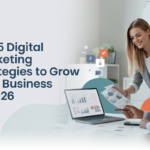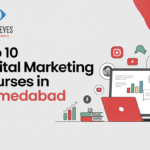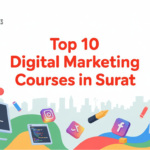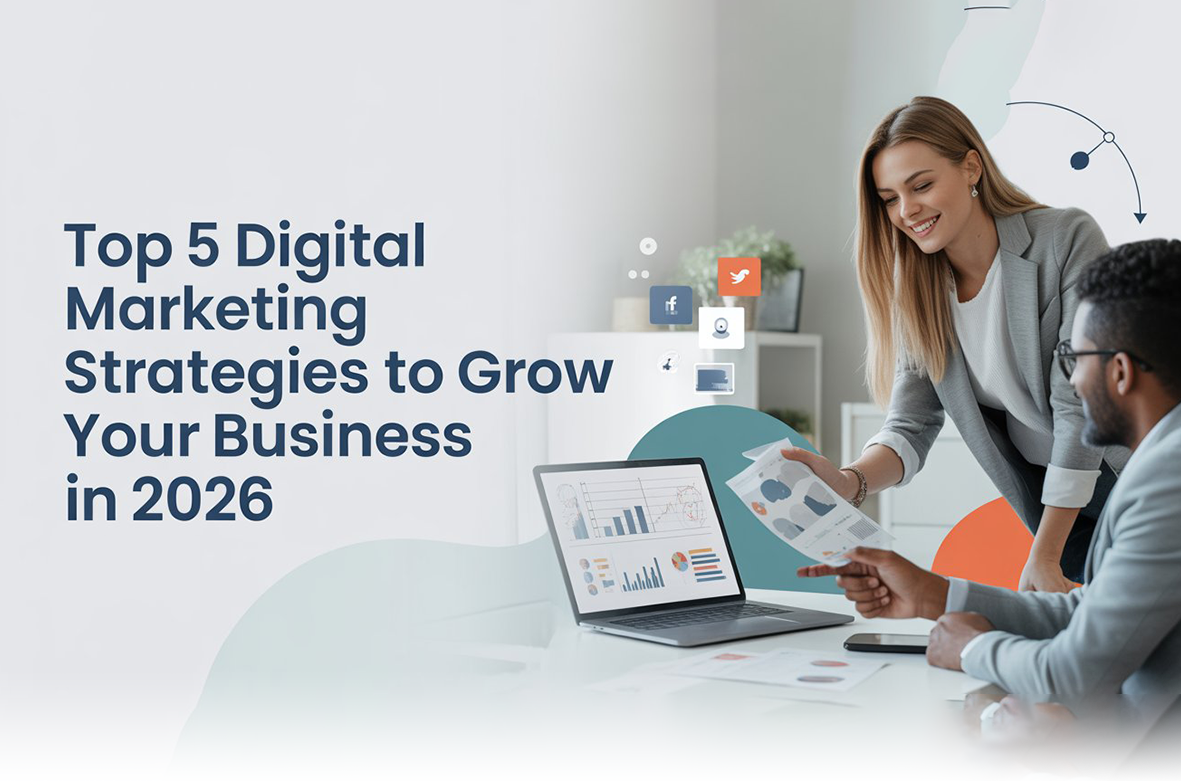
Top 5 Digital Marketing Strategies to Grow Your Business in 2026
In 2026, the digital marketing landscape is evolving faster than ever—powered by AI-driven personalization, smart automation, and data-based decision-making.
For businesses aiming to grow in this competitive era, understanding and implementing the right digital marketing strategies is no longer optional—it’s essential.
Whether you run a startup, small business, or established brand, your online presence defines your success. From optimizing for Google’s latest search algorithms to leveraging social media and influencer collaborations, the right strategies can help you attract, engage, and convert your audience effectively.
This guide uncovers the Top 5 Digital Marketing Strategies to Grow Your Business in 2026 — focusing on SEO, paid advertising, social media marketing, email marketing, and AI-powered influencer marketing.
Each strategy is designed according to Google’s EEAT principles (Experience, Expertise, Authoritativeness, and Trustworthiness) to ensure long-term visibility and credibility.
By the end of this blog, you’ll discover actionable insights, emerging trends, and practical tips to build a strong digital foundation that drives consistent growth throughout 2026 and beyond. Let’s dive in and explore how you can future-proof your business with these proven digital marketing strategies.
What is a Digital Marketing Strategy?
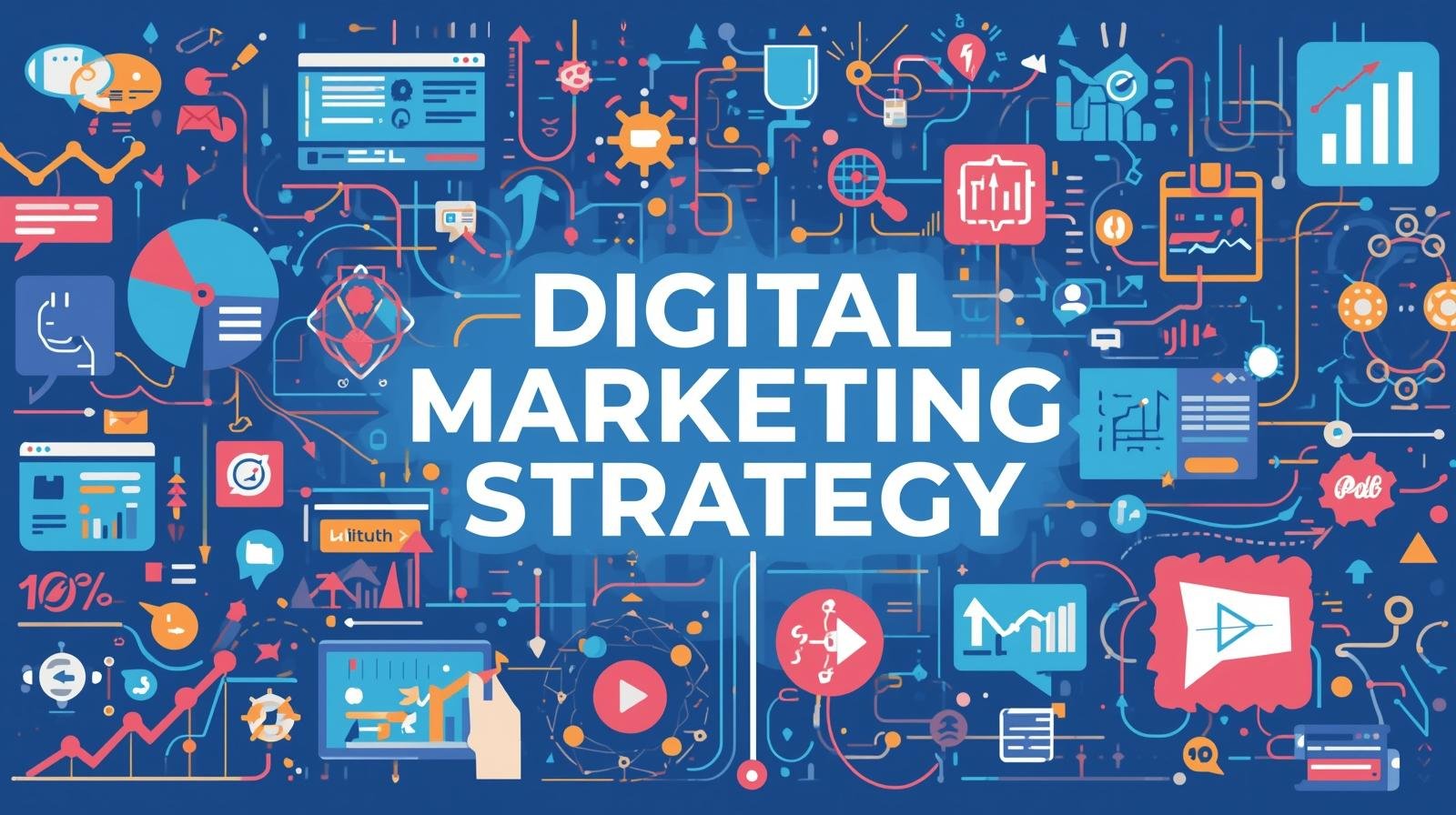
A Digital Marketing Strategy is a well-planned approach that helps a business promote its products or services through online platforms such as search engines, social media, email, and websites. It acts like a roadmap that guides brands toward achieving specific marketing goals — whether it’s increasing brand awareness, generating leads, or boosting sales.
In today’s competitive world, having a clear Digital Marketing Strategy is essential for every business, regardless of its size. It allows companies to connect with the right audience at the right time using data-driven insights. Unlike traditional marketing, digital marketing gives measurable results, letting you track performance in real time and make smarter decisions for future campaigns.
A strong Digital Marketing Strategy usually includes multiple channels such as SEO for better Google visibility, paid ads for quick reach, content marketing to educate customers, and email marketing to build long-term relationships. When all these elements work together under one strategy, they create a powerful online presence that helps a business grow steadily.
Businesses and learners can master these methods by enrolling in a Digital Marketing Course in Ahmedabad, gaining practical skills and insights to design effective, result-driven marketing campaigns.
In short, a Digital Marketing Strategy ensures your marketing efforts are focused, consistent, and aligned with your overall business goals — turning digital opportunities into measurable success.
Why Digital Marketing Is Essential for Business Growth in 2026
In 2026, the way people discover, compare, and buy products has changed completely. Customers now spend most of their time online — searching on Google, scrolling social media, and engaging with brands through personalized content. That’s why having a clear Digital Marketing Strategy has become essential for every business.
It not only helps in reaching the right audience but also ensures that your marketing efforts bring measurable results. Whether you are a small business or an established brand, digital marketing allows you to compete, connect, and grow without geographical limits.
How the Digital Landscape Is Changing for Businesses in 2026
The digital world in 2026 is smarter and more data-driven than ever before. Artificial Intelligence (AI) and automation are now shaping how brands communicate with customers.
Personalized ads, voice search, and short-form videos have become leading trends. Businesses that adapt to these changes through a strategic Digital Marketing Strategy can stay ahead of their competition. With platforms like Google, Instagram, and YouTube constantly updating their algorithms, only brands with a flexible, learning-based approach can maintain long-term visibility and growth.
Why Businesses Need a Future-Ready Marketing Plan
A future-ready marketing plan helps businesses prepare for upcoming changes in technology and consumer behavior. A strong Digital Marketing Strategy gives direction and consistency to all marketing activities — from SEO and paid ads to social media campaigns.
It ensures that your brand remains visible even when digital trends evolve. Planning ahead with clear goals, audience insights, and automation tools helps reduce wasted effort and maximizes your return on investment.
Benefits of Digital Marketing — Visibility, Leads & Revenue
The biggest advantage of a Digital Marketing Strategy is that it delivers measurable business growth. Through SEO, social media, and email marketing, brands gain online visibility, attract high-quality leads, and boost sales.
Unlike traditional marketing, digital channels allow real-time tracking of campaigns, helping businesses make data-driven decisions. In 2026, digital marketing is not just a tool — it’s the foundation for visibility, customer trust, and long-term revenue.
Here are Top 5 Digital Marketing Strategies to Grow Your Business in 2026
1. Search Engine Optimization (SEO)
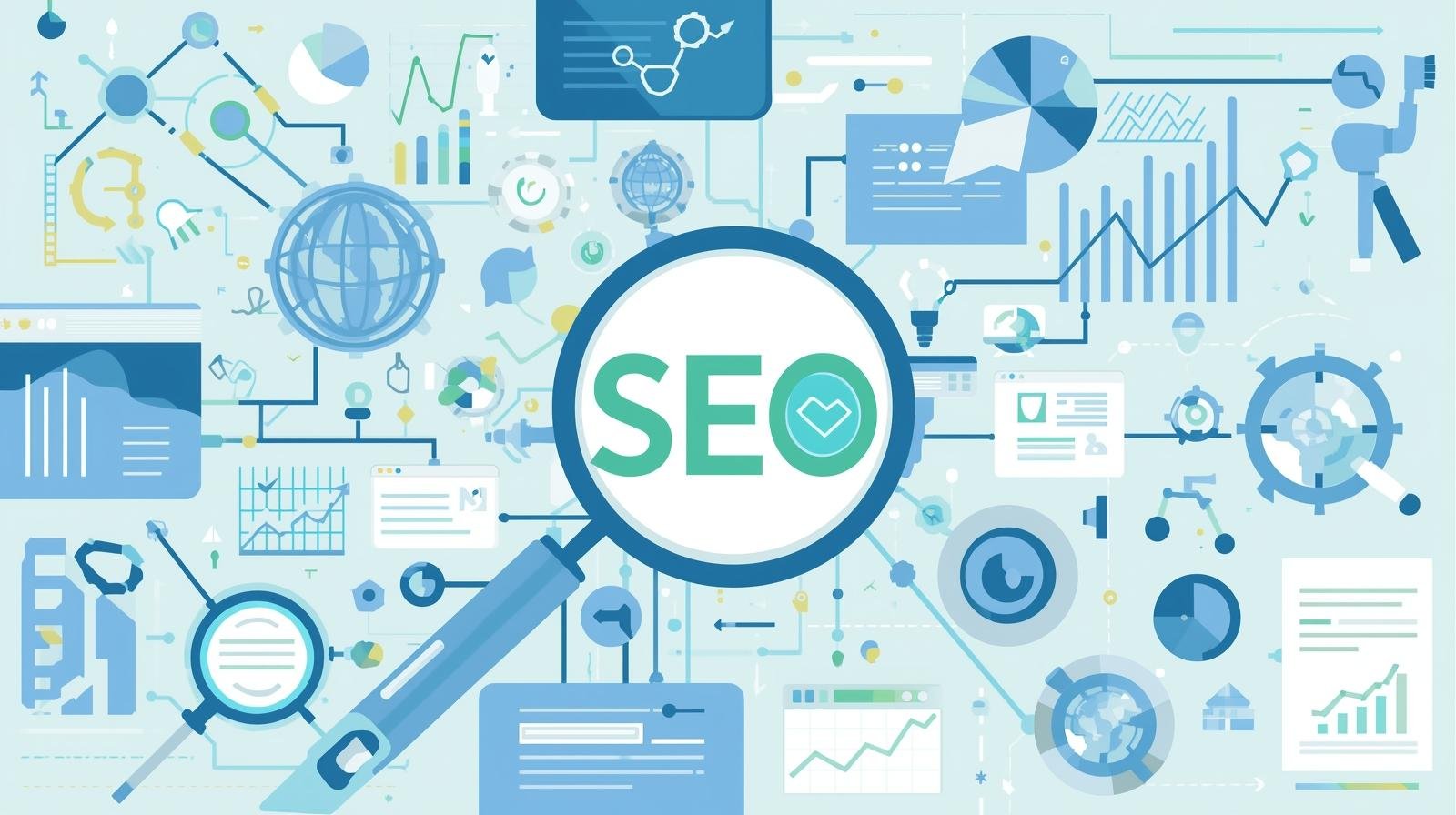
In 2026, Search Engine Optimization (SEO) remains one of the strongest tools for business growth. It helps your website appear higher on Google search results, attract organic visitors, and build long-term trust with your audience. As digital competition increases, SEO ensures that your content reaches the right people at the right time. It focuses on user intent, technical performance, and keyword relevance — all vital to stay competitive.
Whether you’re running a small business or an international brand, a proper SEO plan improves visibility, builds authority, and brings measurable traffic. In short, SEO is not just about ranking higher; it’s about staying relevant in an ever-evolving digital world.
Why SEO Still Matters in 2026
Even in 2026, Search Engine Optimization (SEO) continues to deliver long-term results compared to paid advertising. Customers trust organic search more because it feels authentic and credible.
A strong SEO strategy helps you appear when users actively search for your product or service, leading to qualified leads. Unlike ads that stop when your budget ends, SEO builds a lasting online presence. It improves user experience, strengthens brand authority, and keeps your business visible in competitive markets.
New SEO Trends — Voice Search, AI Content, and EEAT Optimization
Modern Search Engine Optimization (SEO) focuses on personalization and user intent. Voice search is growing, meaning people now use natural questions instead of short keywords. AI tools help create content faster, but Google rewards pages that reflect human expertise and follow EEAT — Experience, Expertise, Authoritativeness, and Trustworthiness. Optimizing for voice, AI, and EEAT together ensures better ranking and stronger brand credibility. Businesses that embrace these trends stay future-ready.
Local SEO for Small Businesses and Startups
Local Search Engine Optimization (SEO) for small businesses helps to reach nearby customers. Optimize your Google Business Profile with accurate details, photos, and reviews. Use local keywords like “near me” or city-based terms to appear in regional searches. Consistent NAP (Name, Address, Phone) details across platforms improve local trust and visibility. For startups, Local SEO is cost-effective and brings faster results — driving foot traffic, calls, and local inquiries that directly boost sales.
2. Paid Advertising (PPC & Performance Marketing)
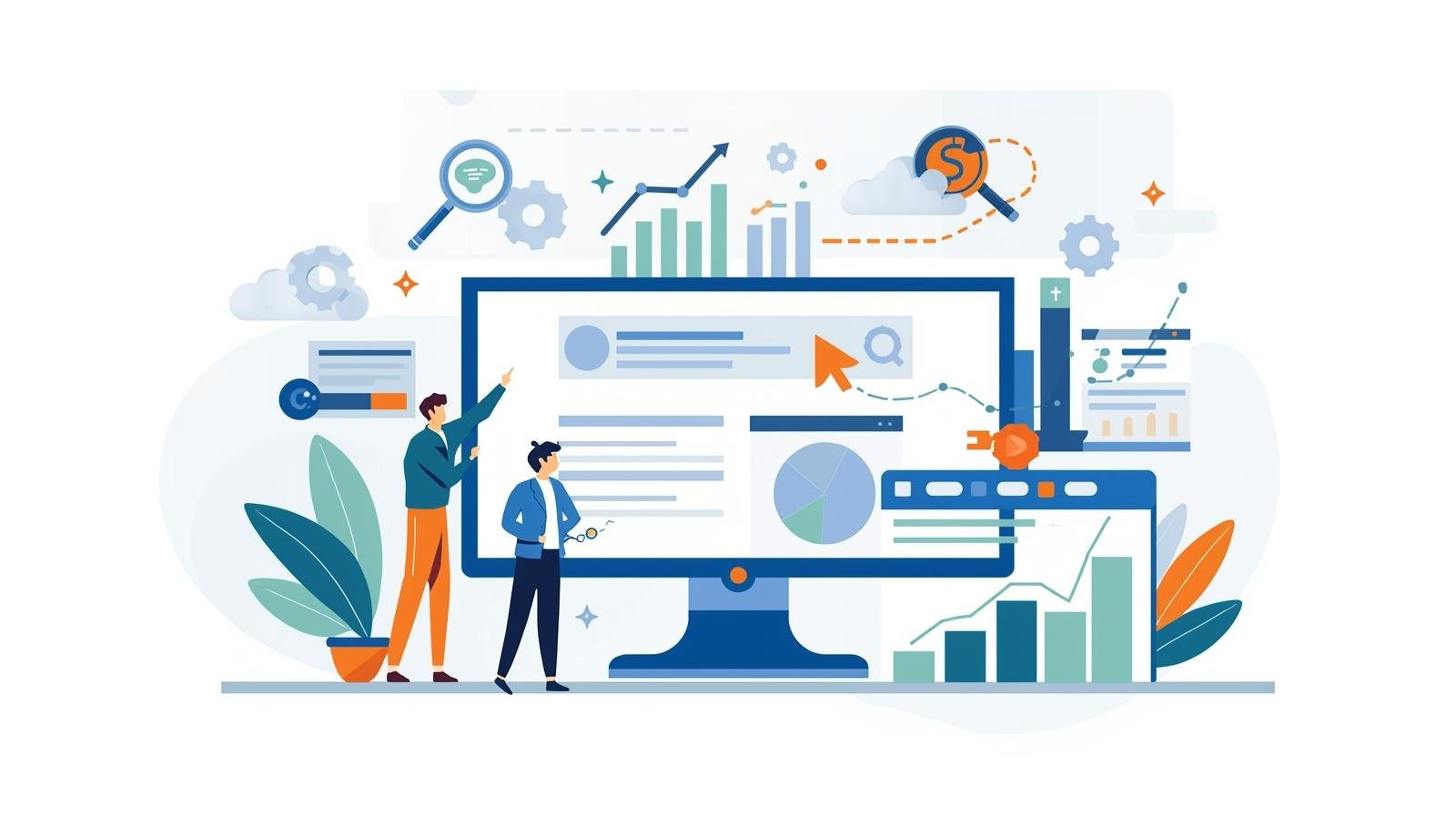
In 2026, Paid Advertising (PPC) continues to be one of the fastest ways to gain visibility, attract customers, and grow your business online. Unlike organic methods, PPC delivers instant results by placing your brand in front of the right audience at the right time. Platforms like Google Ads, Meta Ads, and YouTube Ads allow businesses to target users based on location, behavior, and interests. This makes Paid Advertising (PPC) ideal for startups and small businesses that want measurable returns on investment.
When done strategically, PPC not only drives traffic but also helps brands understand which campaigns convert best. By combining smart bidding, compelling ad creatives, and proper audience targeting, performance marketing ensures every click brings real value.
Understanding the Role of PPC in Business Growth
Paid Advertising (PPC) plays a major role in helping businesses scale faster. It brings instant exposure on Google and social media platforms, reaching users actively searching for similar products or services.
PPC allows precise control over your budget, making it ideal for both small and large businesses. By tracking clicks, impressions, and conversions, you can refine campaigns and achieve higher ROI.
Google Ads vs Meta Ads — Which Works Best in 2026?
Both Google Ads and Meta Ads are powerful Paid Advertising (PPC) platforms but serve different goals. Google Ads targets users based on search intent, perfect for capturing high-intent buyers.
Meta Ads (Facebook & Instagram) focus on visual storytelling, ideal for brand awareness and engagement. The best results in 2026 come from combining both — using Google Ads for conversions and Meta Ads for brand visibility.
Retargeting and Conversion Optimization Strategies
Retargeting is an advanced form of Paid Advertising (PPC) that reminds potential customers to take action. When users visit your site but don’t buy, retargeting ads follow them across platforms, increasing conversions.
Combined with A/B testing, optimized landing pages, and personalized ad creatives, retargeting can boost ROI by up to 70%. It’s an essential part of every modern performance marketing strategy.
Budget Planning for Paid Campaigns That Deliver ROI
A successful Paid Advertising (PPC) campaign requires smart budgeting. Start small, test different ad creatives, and invest more in what performs best.
Always monitor cost-per-click (CPC), conversion rate, and customer lifetime value (CLV). Using analytics tools helps you allocate funds efficiently and avoid waste. With careful planning, even a limited budget can deliver strong ROI and scalable growth in 2026.
3. Social Media Marketing (SMM): Build Brand Awareness and Engagement
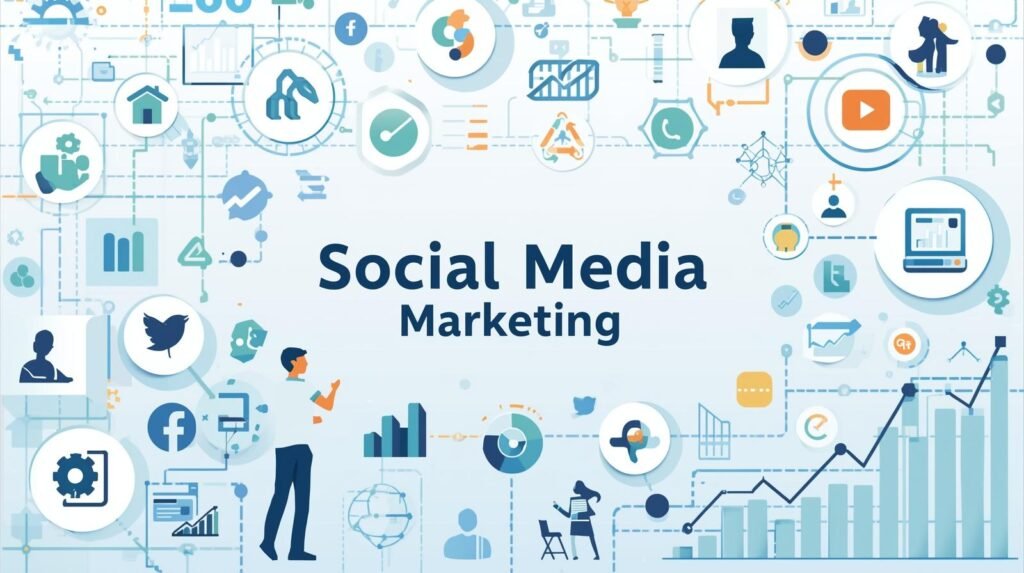
In 2026, Social Media Marketing (SMM) remains one of the most powerful digital tools for business growth. With billions of active users across platforms like Instagram, LinkedIn, Facebook, and YouTube, social media gives brands the chance to connect directly with their audience. It’s not just about posting — it’s about building meaningful engagement through authentic content, storytelling, and consistent communication.
A strong Social Media Marketing (SMM) plan helps increase brand visibility, drive website traffic, and improve customer loyalty. From short-form videos to interactive polls and influencer collaborations, social media trends are constantly evolving. Businesses that stay consistent, understand their audience, and use data-driven insights will continue to grow their brand reach in 2026 and beyond.
Top Social Platforms for Businesses in 2026
The best platforms for Social Media Marketing (SMM) in 2026 depend on your business goals. Instagram and TikTok dominate for visual storytelling, while LinkedIn remains the top platform for B2B networking.
Facebook is ideal for community building and local reach, and YouTube continues to lead video marketing. Using a mix of these platforms allows brands to connect with different audiences and maximize engagement.
How to Create Content That Drives Organic Reach
To succeed in Social Media Marketing (SMM), content must be engaging, consistent, and relatable. Focus on short videos, user-generated posts, and trending topics that align with your brand voice. Use relevant hashtags and post during peak hours to reach more people organically. Encourage conversations through polls, comments, and shares — this helps improve visibility without relying on paid promotions.
Social Commerce and Influencer Marketing Integration
In 2026, Social Media Marketing (SMM) and e-commerce are more connected than ever. Platforms now let users shop directly through posts, stories, and live videos. Partnering with influencers also helps brands build trust and drive sales. Micro-influencers, in particular, deliver higher engagement and genuine recommendations. Combining influencer partnerships with social commerce boosts both reach and conversions effectively.
Using Reels, Shorts, and Live Content to Grow Fast
Short-form videos like Reels and YouTube Shorts are at the heart of Social Media Marketing (SMM) in 2026. These quick, engaging videos capture attention instantly and increase brand exposure. Live sessions add authenticity, allowing real-time interaction with followers. Using these formats strategically helps businesses grow faster, improve engagement rates, and stay relevant in a competitive digital world.
4. Email Marketing
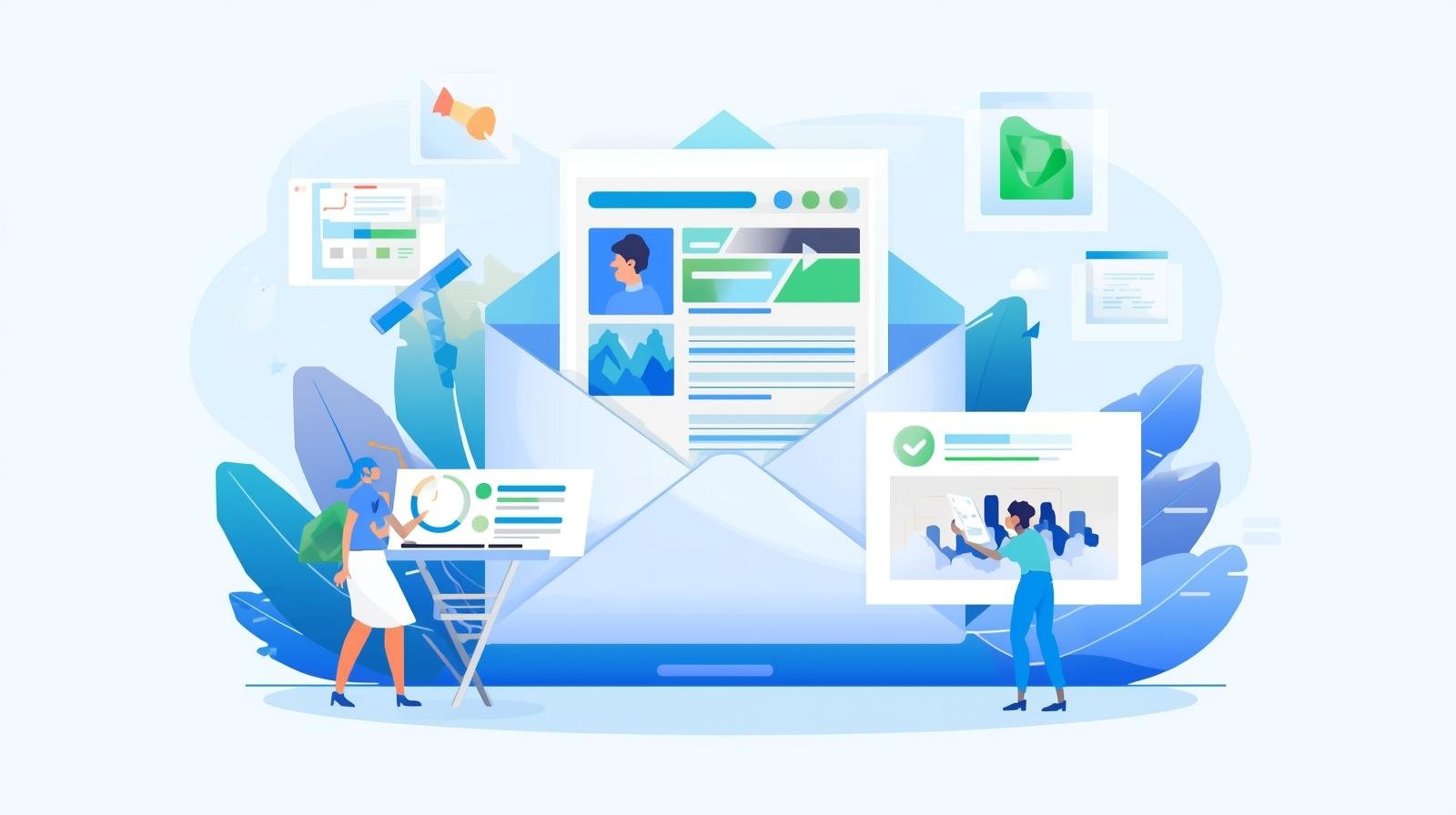
In 2026, Email Marketing and Automation remains one of the most effective ways to build lasting relationships with customers. Unlike social media, email offers a direct and personal way to reach your audience. It helps businesses share updates, promote offers, and nurture leads until they’re ready to buy.
With smart automation tools, brands can now send personalized messages based on customer behavior — like welcome emails, cart reminders, and product recommendations. The strength of Email Marketing and Automation lies in its ability to turn one-time visitors into repeat buyers. It’s cost-effective, measurable, and delivers one of the highest returns on investment among all digital marketing methods. When combined with a strong content plan and segmentation strategy, email marketing can build trust and boost revenue consistently.
Why Email Marketing Is Still the Highest ROI Channel
Email Marketing and Automation continues to deliver exceptional ROI because it connects directly with your audience. You own your email list, so you’re not dependent on algorithms or platform changes.
Emails can be personalized for each subscriber, increasing engagement and conversion rates. With the right message and timing, every email becomes a sales opportunity that strengthens customer relationships.
How to Build Personalized and Automated Campaigns
Creating successful Email Marketing and Automation campaigns starts with understanding your audience. Segment your list based on interests, behavior, or location.
Use automation tools to send relevant emails automatically — such as onboarding sequences, product updates, or event invitations. Personalized subject lines and content improve open rates and engagement. The key is consistency and value in every message.
Using AI Tools for Smarter Email Segmentation
AI is transforming Email Marketing and Automation by making personalization faster and more accurate.
AI tools can predict customer behavior, suggest the best sending times, and even generate subject lines. They help marketers identify which content performs best and how to target specific audience groups. This smart segmentation improves engagement while reducing manual effort.
Best Email Marketing Tools for Businesses in 2026
Businesses can simplify Email Marketing and Automation using tools like Mailchimp, HubSpot, and ActiveCampaign. These platforms offer templates, analytics, and automation workflows that save time and improve performance.
Choosing the right tool depends on your goals — whether it’s nurturing leads, promoting sales, or sharing content. With the right setup, even small businesses can manage professional and effective campaigns effortlessly.
5. Influencer and AI-Powered Marketing
In 2026, Influencer and AI-Powered Marketing are reshaping how brands connect with audiences. Consumers now trust recommendations from real people more than traditional ads, making influencer marketing a key driver of online growth. At the same time, Artificial Intelligence (AI) is changing how marketers plan, create, and optimize campaigns.
AI tools can analyze audience data, track engagement, and predict the best-performing content. When combined, Influencer and AI-Powered Marketing create powerful results — influencers bring authenticity, while AI ensures precision and personalization. This combination helps brands reach the right audience with the right message at the right time. From small startups to global companies, this modern approach builds credibility, saves time, and maximizes marketing ROI.
How Influencer Marketing Builds Trust and Awareness
Influencer and AI-Powered Marketing helps brands connect with audiences through genuine human interaction. Influencers already have loyal communities that value their opinions.
By partnering with them, businesses gain instant credibility and reach. Influencer endorsements feel more personal and relatable than paid ads, making them highly effective for building brand awareness and trust.
Rise of AI-Generated Campaigns and Smart Targeting
AI plays a big role in Influencer and AI-Powered Marketing by automating repetitive tasks and improving decision-making. It helps brands find the best influencers, analyze audience behavior, and personalize campaigns.
AI-generated insights allow marketers to predict trends and choose the right platforms for maximum engagement. This smart targeting saves money and boosts campaign performance.
How to Collaborate with Micro-Influencers for Maximum ROI
Micro-influencers are the backbone of Influencer and AI-Powered Marketing. They have smaller but more loyal audiences, which often leads to better engagement rates. Collaborating with them is cost-effective and delivers authentic results.
By using AI tools to analyze influencer performance and match them with your niche, brands can achieve higher ROI and meaningful brand exposure.
Real Examples of Successful AI-Driven Campaigns
Leading brands are using Influencer and AI-Powered Marketing to design smarter campaigns. For example, fashion brands use AI to identify trending styles, while influencers showcase those products through relatable videos.
AI also helps track campaign metrics in real time, ensuring transparency and improved strategy. These AI-driven collaborations prove that when creativity meets technology, marketing success becomes predictable and scalable.
How to Combine All 5 Strategies for Maximum Growth
The true power of Digital Marketing Strategies comes when all channels work together in harmony. SEO brings organic visibility, PPC drives quick traffic, social media builds awareness, email nurtures relationships, and influencer marketing strengthens brand credibility. When you combine these five strategies, your business builds a strong online presence that attracts, converts, and retains customers. The key is to connect every channel with a common goal — increasing brand trust and sales. In 2026, successful marketers don’t rely on a single tactic; they create integrated systems.
By tracking user behavior across platforms and using AI tools for insights, businesses can deliver personalized experiences at every stage of the customer journey. To master these techniques, joining a Digital Marketing Course in Surat can help you learn how to apply these strategies effectively for real business growth.
Building an Integrated Marketing Funnel
An integrated funnel connects all your Digital Marketing Strategies — from awareness to conversion. For example, SEO drives traffic, paid ads retarget those visitors, and email marketing nurtures them into customers.
Each strategy plays a role in moving users closer to purchase. A well-structured funnel ensures no lead is wasted and every touchpoint adds value.
Balancing Organic and Paid Growth
Smart marketers balance organic and paid Digital Marketing Strategies to get consistent results. SEO and social media help build free, long-term traffic, while paid ads bring faster visibility.
Combining both ensures continuous growth — quick wins from ads and sustainable reach from organic efforts. This balance creates a reliable system for business expansion.
Using Data and Analytics to Improve Conversions
Data is the foundation of modern Digital Marketing Strategies. Analytics tools like Google Analytics and Meta Insights show what’s working and what needs improvement. By studying click-through rates, bounce rates, and conversions, businesses can adjust campaigns for better performance.
Data-driven decisions turn guesswork into growth and make every marketing effort more profitable.
Final Thoughts
As we move deeper into 2026, one thing is clear — success in the online world depends on how well a brand adapts and integrates the right Digital Marketing Strategies. From building visibility through SEO to driving fast results with PPC, engaging audiences on social media, nurturing leads via email marketing, and building trust through influencer collaborations — every strategy plays a vital role in sustainable growth.
A future-ready business doesn’t rely on a single channel; it blends technology, creativity, and data to create consistent value for its audience. With the rise of AI, automation, and personalized content, digital marketing is no longer just about promotion — it’s about building meaningful connections.
By following the principles of Google EEAT — experience, expertise, authoritativeness, and trustworthiness — your marketing efforts can stand out in both search results and customer minds. Start applying these strategies today to stay relevant, competitive, and successful in 2026 and beyond.
FAQS
The best digital marketing strategies for 2026 include SEO, paid advertising (PPC), social media marketing, email automation, and influencer collaborations. These strategies help businesses build visibility, attract leads, and increase revenue. When integrated, they create a powerful system for consistent growth. Using AI tools, automation, and data analytics will make these strategies even more effective in achieving measurable marketing success.
Digital marketing is essential because it connects businesses with their target audience online. It helps increase brand visibility, attract qualified leads, and improve customer engagement. With tools like SEO, PPC, and social media, businesses can measure results in real time and make data-driven decisions. In 2026, digital marketing remains the most cost-effective way to grow and compete globally.
Search Engine Optimization (SEO) helps businesses appear higher in Google search results, driving organic traffic and building trust. In 2026, SEO focuses on user intent, AI-generated content, and EEAT principles. By optimizing content and website performance, businesses gain visibility, attract potential customers, and achieve long-term growth without relying only on paid advertising.
Paid Advertising (PPC) delivers the fastest results because it brings instant visibility and traffic. Platforms like Google Ads and Meta Ads help businesses target specific audiences and drive conversions quickly. However, combining PPC with SEO and social media ensures sustainable growth and long-term returns. The best strategy depends on business goals and budget.
Social media marketing helps businesses connect with their audience, build brand awareness, and boost engagement. Platforms like Instagram, LinkedIn, and YouTube allow brands to share stories, run ads, and collaborate with influencers. In 2026, social media is also a major sales channel through social commerce, making it a key part of every business’s growth strategy.
Yes, email marketing remains highly effective in 2026. It provides direct communication with customers, delivers personalized offers, and nurtures leads into loyal buyers. Automation and AI tools now make email campaigns smarter, improving open rates and engagement. It’s one of the most cost-efficient ways to maintain customer relationships and increase repeat sales.
Influencer marketing involves partnering with individuals who have loyal followers online. These influencers promote your products or services through authentic content, building trust and awareness. In 2026, influencer marketing combined with AI insights allows businesses to reach targeted audiences more effectively, boost credibility, and increase sales through genuine recommendations.
Small businesses can use digital marketing to compete with larger brands affordably. Strategies like local SEO, social media, and paid ads help attract nearby customers and build recognition. With smart tools and automation, small businesses can manage campaigns efficiently, gain visibility online, and convert leads into paying customers without huge budgets.
Key digital marketing trends in 2026 include AI-driven content, voice search optimization, video marketing, and automation. Brands are focusing on personalization, sustainability, and user experience. Tools powered by AI and analytics help businesses make smarter decisions, optimize ads, and deliver customized content that connects emotionally with their audience.
To create a successful digital marketing plan in 2026, start by identifying your target audience, setting clear goals, and selecting the right channels — SEO, PPC, social media, email, and influencer marketing. Use AI tools for data analysis, set measurable KPIs, and monitor performance regularly. Adjust strategies based on results for continuous improvement and growth.

